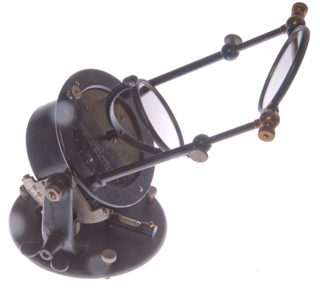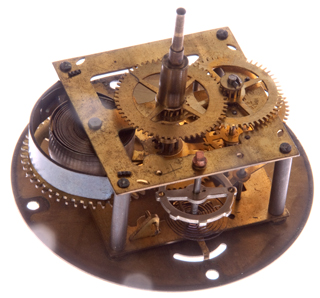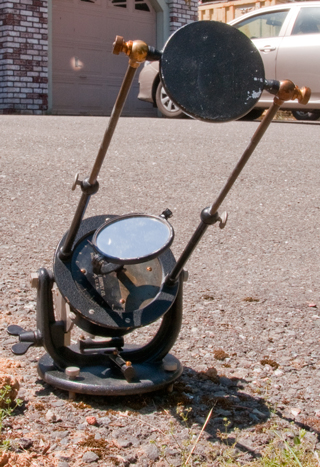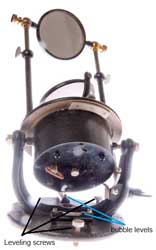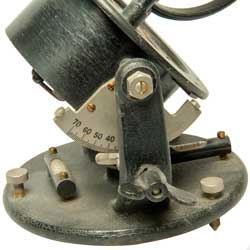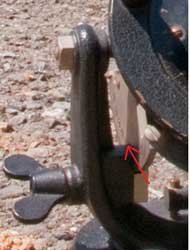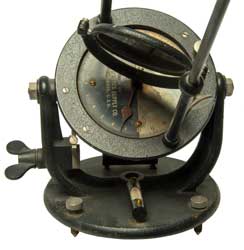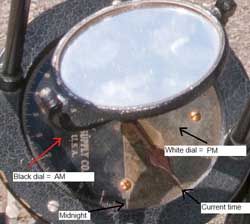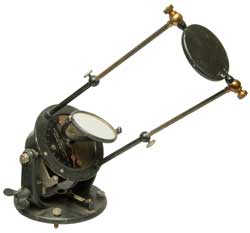Eastern Science Supply Co. Heliostat
© Brooke Clarke 2016 - 2023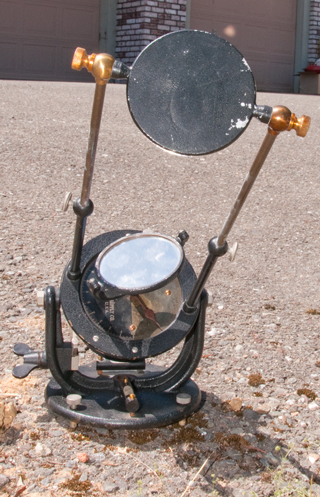
Description
Photos
Setup Procedure
Related
Patents
References
Links
Background
For a very long time I've had an interest in Heliostats (Wiki). I think that's what this is. Made by Eastern Science Supply Co. (ESSCo), Boston Mass. I expect it was intended as an astronomy demonstration device, but not sure. Have a book on order "Study, Measure Experiment, stories of Scientific Instruments at Dartmouth College" which may have some information. If you know about this please contact me.
This instrument has the look and feel of the Mance Type Mk V Heliograph. The purpose of the Heliograph is signaling whereas the purpose of the Heliostat is to aim the Sun's beam at a fixed target.
This instrument appears to be more modern that the Viennese instrument of 1850 shown on the Wiki Heliostat web page. It's missing the plumb bob for the latitude scale, you can see the hole where it should attach.
It turns out that Leon Foucault worked with Heliostats as well as the Foucault pendulum (Wiki) and named the Gyroscope. All these things relate to the rotation of the Earth. Here are some links about that by Luca:
heliostat studies -
Description du sidérostat de L. Foucault -
Recueil des travaux scientifique de Leon Foucault (Raccolta di lavori scientifici di Leon Foucault) -
Update foucault-1900-maxi.md -
Gear Generator -
Description
This may more correctly be called a type 1 coelostat (Wiki, Red Rock) because it has two mirrors.
The base has a couple of level vials so that the horizontal tilt axis will be level. There is a latitude scale allowing the main rotation axis to be set so it points to the celestial pole. There is a clockwork mechanism to rotate the mirrors to de-spin the Earth. The adjustable length mirror support rods and the top mirror can be rotated relative to the base by using the thumb screw on the top of the clockwork. This allows aiming the top mirror in hour angle. The bottom mirror should be driven by the clockwork, but appears to move free. Probably something inside is loose or broken. On the bottom of the clockwork there is a key to wind the mainspring, but it's tight, i.e. the spring is fully wound. There is also a rate adjustment. In the center bottom there's a thumb screw that directly turns the clockwork output shaft.
There is a threaded hole at the center of the base, but it's too small for a 5/8-11 surveying tripod and too big (about 1/2") for either a 1/4-20 or 3/8-16 European camera tripod. Probably made before these were standardized.
The reason that the mirror moved freely was that it's pinch screw was not tightened to the shaft.
1 July 2016 cleaned & oiled, now running. After a couple of shots of Berryman's B-12 it started running. Oiled with Nye Clock Oil 140B.
It's going to take some hours for the mainspring to open so that Mobil 1 oil can be worked into the flats. Am applying Mobil 1 to the mainspring as it winds down.
After 22 hours it's still ticking. But the mainspring looks almost unwound.
Photos
Setup Procedure
This came from Luca who has a GitHub about heliostats.
1. Place it on flat plane, then use the 3 screws to be sure it's perfectly horizontal (thanks to the bubble levels):
3. Release the screw of the lower mirror, and rotate the mirror until the arrow points to current Local Mean Time (Wiki), then tighten the screw to fix the mirror to the axle:
4. Release the screws of the upper mirror, rotate it until it is othogonal to the polar axis, then tighten the screws:
5. Rotate the lower mirror about its free axis until the sun is reflected on the second mirror, then tighten the screws.
Now you can "customize" the reflection direction: release both upper and lower screws of the seconday mirror, direct the reflection where you like, then tighten the screws:Now the heliostat is calibrated.
The heliostat will keep working properly for a couple days, then you will need rotating a bit the lower mirror to adapt it to how sun declination changes along the year; all other tunings are valid for ever, or until you move the heliostat to another place.
Related
Astronomy
Gyroscope - Foucault -
Pendulums - related to gravity and time
Navigation
Stellar Time -
Theodolite
Time and Frequency
Ukiah Latitude Observatory - Photographic Zenith Tube
Warren Knight PIBAL Theodolite
Patents
----------------Waterbury Clock Co. ---------------
------------------------ Heliostat --------------------
Waterbury has many clock related patents. This mechanism makes use of 3 of their Lantern-pinions. Since the patent was filed in 1904 the was probably made after that date?
787041, Lantern-pinion, Ernest H Horn, Waterbury Clock Co, Apr 11, 1905, 368/322; 968/93 -
1440426 Pivotal guard for clock springs, Frederick Wehinger, Waterbury Clock Co, Jan 2, 1923, 368/141, 968/377 - Maybe made after filing date Sep 29, 1922?
1546075 Balance-staff bearing for timepieces, Horn Ernest H, Waterbury Clock Co, Jul 14, 1925, 368/324, 968/278, 384/244 -
31060 Enlarging Photographic Pictures, John H. Whitley, Jan 1, 1861, 353/3 - requires Sun tracking
54118 Arrangement of solar mirror for photographic purposes, Apr 24, 1866, 353/3 -
59438 Solar Camera, L. F. Moeawetz, Nov 6, 1866, 353/3 -
250672 Heliostat, L. D. McIntosh, 1881-12-13 - for use with horizontal microscope
333769 Heliostat, A.M. Mayer, 1886-01-05, 353/3 - uses lens
509390 Solar Heater, H.E. Paine, 1893-11-28 -
DE 326516 Heliostat for astronomical purposes, Gustav Heyde G M B H, Sep 29, 1920,
1976428 Self regulating heliostat, Arthuys Jacques Marie, Bayle Andre, Said Arthel Society, 1934-10-09, - Mercury switch (or solar sensor) and electromagnet on ratchet wheel
2135997 Automatic heliostat, Arthuys Jacques Marie, Arthel Societe, 1938-11-08, - Mercury switch (or solar sensor) and electric motors via slip rings (Mercury).
2712772 Self-regulating automatic heliostat reflecting mirror device, Trombe Felix, Ceutre Nat De La Rechscient, 1955-07-12, - Sun sensors and screw jacks
3446980 Stabilized sight system employing autocollimation of gyro-stabilized light beam to correct yaw and pitch orientation of coupled sight line and servo system mirrors, Rudolf H Meier, Philco Ford Corp, 1969-05-27, - uses 4-quadrant photo sensor and servo motors.
514669 Heliomotor, Luther W. Allingham, Feb 13, 1894, 359/853; 126/605; 126/684; 359/876 -
References
A Manual of Laboratory Astronomy, for use in introductory courses by Harlan True Stetson Phd, Eastern Science Supply Co, 1928 - but no mention of the heliostat.
Study, Measure, Experiment: Stories of Scientific Instruments at Dartmouth College by David Pantalony Richard Kreme & Francis Manasek 2005 - mentions a number of ESSCo instruments, but not this one.
Red Rock Solar Heliostats - Coelostat type 1 -
Instruments for Natural Philosophy - Optics - Heliostats
A Note on the Principle and Nomenclature of Heliostats, Coelostats, Siderostats, by Dougherty, 1982 -
Links
PRC68, Alphanumeric Index of Web pages, Contact, Products for Sale
Page Created 2016, June 29.
